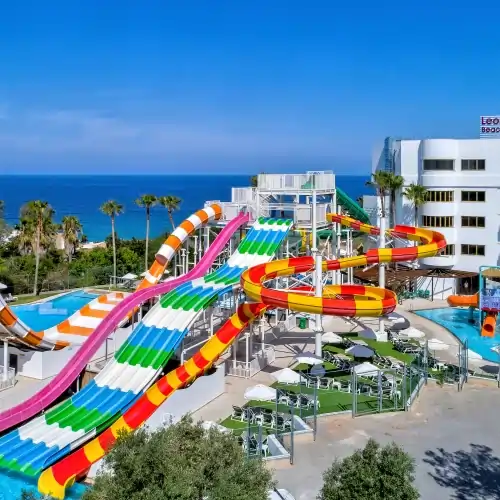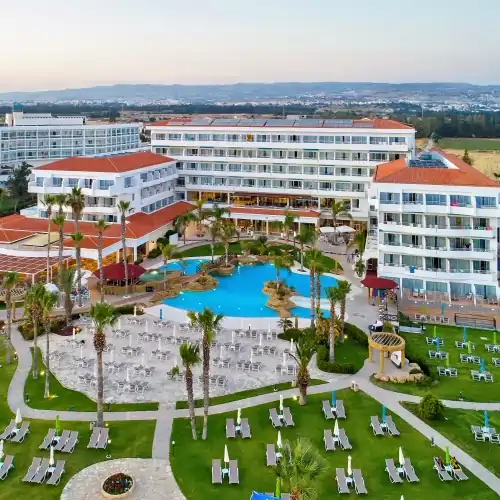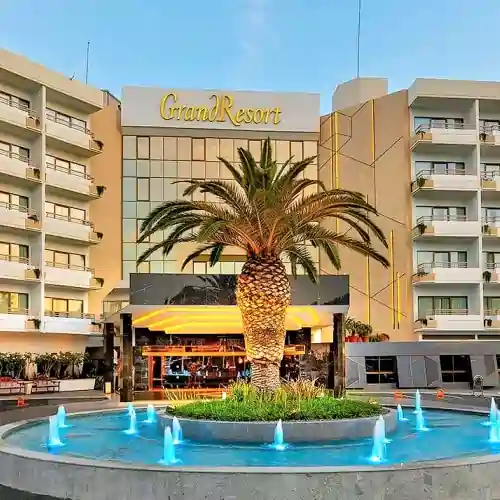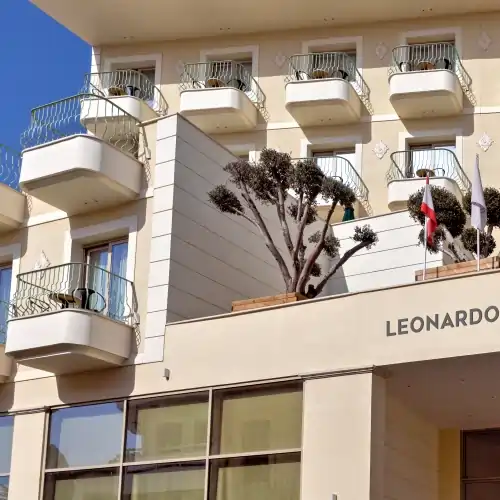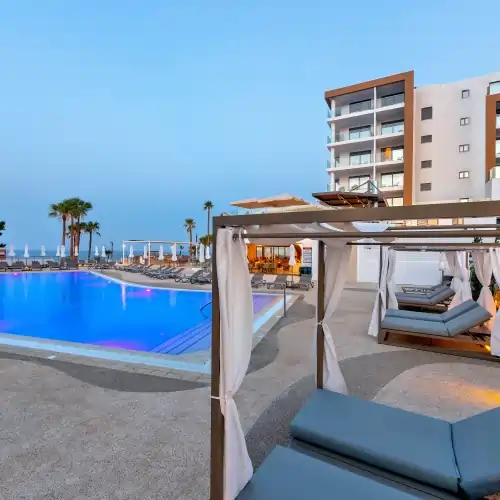- Book Now
- Home Page
- Destinations
- City Guides
- City Guides
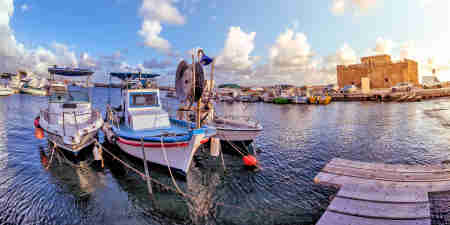 Explore Paphos
Explore Paphos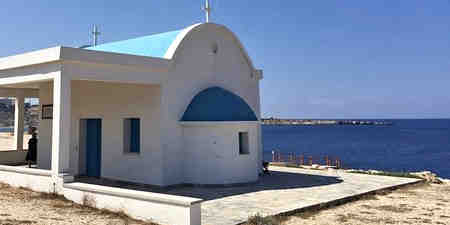 Explore Protaras
Explore Protaras
- Special Offers
- Weddings
- Meetings & Events
- About Us
- Contact Us
- Get A Quote
- Manage your Bookings
- English
One of the easiest ways to understand why Cyprus is so special is to walk on the beach at Petra tou Romiou – the mythological birthplace of the goddess of love, Aphrodite. This is one of the prettiest stops on the Aphrodite Cultural Route.
The Legends of Petra tou Romiou
Petra tou Romiou, also Aphrodite’s Rock is a stack at the shores of the sea in Kouklia. According to the legend, this is the place where the goddess of love emerged from the sea. This passage from Homer’s Hymn to Aphrodite (VI.1) tells the story of her Cypriot origins:
“I will sing of stately Aphrodite, gold-crowned and beautiful, whose dominion is the walled cities of all sea-set Cyprus. There the moist breath of the western wind wafted her over the waves of the loud-moaning sea in soft foam, and there the gold-filleted Hours welcomed her joyously. They clothed her with heavenly garments: on her head they put a fine, well-wrought crown of gold, and in her pierced ears they hung ornaments of orichalc and precious gold, and adorned her with golden necklaces over her soft neck and snow-white breasts, jewels which the gold-filleted Hours wear themselves whenever they go to their father's house to join the lovely dances of the gods. And when they had fully decked her, they brought her to the gods, who welcomed her when they saw her, giving her their hands. Each one of them prayed that he might lead her home to be his wedded wife, so greatly were they amazed at the beauty of violet-crowned Cytherea.”
The birth of the goddess is depicted in many artworks, of which, the most distinctive is Botticelli's Birth of Venus, a Renaissance masterpiece currently on display at the Uffizi Gallery in Florence, Italy.
Hesiod’s Theogony account of the birth of the goddess of love is different: she was born out of the foam of the sea after Uranus was attacked by his son Cronos with a sickle and his genitals were cast into the “surging sea:”
“They were swept away over the main a long time: and a white foam spread around them from the immortal flesh, and in it there grew a maiden. First she drew near holy Cythera, and from there, afterwards, she came to sea-girt Cyprus, and came forth an awful and lovely goddess, and grass grew up about her beneath her shapely feet. Her gods and men call Aphrodite, and the foam-born goddess and rich-crowned Cytherea, because she grew amid the foam, and Cytherea because she reached Cythera, and Cyprogenes because she was born in billowy Cyprus, and Philommedes because she sprang from the members. And with her went Eros, and comely Desire followed her at her birth at the first and as she went into the assembly of the gods. This honor she has from the beginning, and this is the portion allotted to her amongst men and undying gods,— the whisperings of maidens and smiles and deceits with sweet delight and love and graciousness.”
Aphrodite’s birth is not the only myth linked with Petra tou Romiou. In English translation, Petra tou Romiou means the “Rock of the Greek,” and it connects to the epic hero Basil, called “Digenes Akritas.” Digenes Akritas means “Two-Blood Border Lord,” which refers to his mixed Byzantine-Cappadocian Greek and Arab blood. According to this legend, Basil threw the rock into the sea to destroy Arab ships during a raid by the Saracens looking to take over the island.
As fascinating as these legends may be, nothing compares to the vision of the rock emerging from the foamy sea in Kouklia, on the way from Paphos to Limassol. The beach at Petra tou Romiou is one of the most popular tourist landmarks in Cyprus, attracting thousands of visitors year-round. For those who believe in Greek legends, swimming three times around Aphrodite’s Rock secures everlasting love. The breathtaking landscapes surrounding Petra tou Romiou are a mesmerizing sight too. It’s worth to take your camera to capture a memento of your visit. As soon as you see this spot in real life, you will understand why so many couples choose it for wedding photography.
The beach at Petra tou Romiou is pebbly, which keeps the water sparkling clean. It attracts mainly foreign tourists from Germany, United Kingdom, Russia, and the Netherlands, although it is not uncommon to find some of the locals splashing around in the sea around the rock too. There are no facilities of any kind on the beach so come prepared.
Read More
Read Less




The Geroskipou Municipal Beach is an institution of sorts in this part of Paphos. It all started when Ricco’s Bar opened back in 1975 on a rocky shore. But the locals – including authorities – saw potential in this place and transformed the bare coast of the sea into a Blue Flag sensation. Literally.
Geroskipou Municipal Beach: A Fantastic Snorkeling Spot
The Geroskipou Municipal Beach, also spelled “Yeroskipou,” traces its roots back to Ricco’s Bar, which opened in 1975. The bar still stands – a lifestyle institution of sorts at the shores of the sea. It’s a perfect setting for all kinds of outings. The family owning the place planted the trees that currently offer their generous shade over the sands and make the beach look like a lush Mediterranean paradise. They watched them grow over the years, and, due to the bar’s increased appeal, the local authorities, decided to develop and modernize the beach, depositing tons of sand on the rocky shorelines and building breakwaters to keep their new creation safe against the rage of the waves.
Ricco’s Bar has unique appeal at the Geroskipou Municipal Beach. It’s lovely decorated, boasting paths in checkered white and blue and cobalt tree houses, plus sunbeds with heavy mattresses for added comfort.
Geroskipou Municipal Beach, as a whole, counts among the top favorites of the Cypriots. Many of the locals come here every weekend to relax and take in the sunshine and the breeze. There are also concerts and thematic events in the summer, most of them organized by the local bars and taverns.
The breakwaters keep the waters shallow, calm, and safe for swimming. In addition, beachgoers can also rent jet skis, banana boats, or try out flyboarding – the coolest adrenaline-filled watersport available at Geroskipou Municipal Beach. If you are not into watersports, you can always play beach volleyball or other games – there are already fields to meet your sporting needs. Snorkeling is a good idea too because, occasionally, you can spot all kinds of marine creatures, including Green or Loggerhead Sea turtles.
The Geroskipou Municipal Beach is well-organized, with sunbeds and umbrellas harmoniously lining up the shore, plus enough changing rooms and showers, and lifeguards on duty from April until October. There are also playgrounds for children, plus bars and a family-run fish tavern that serves authentic fare to die for.
Read More
Read Less



The Municipal Bath Beach, which is also known as the Kato Paphos Beach, stretches from Yeroskipou towards the Paphos harbor along the Poseidonos Avenue. It is a favorite destination for experienced swimmers, as its waters are deep and clean.
The Municipal Bath Beach Is a Playground for Skilled Swimmers
The Municipal Bath Beach is not your usual family-friendly sunbathing destination. It’s mainly rocky, and its clear waters are deep and dangerous if you are not a skilled swimmer. Hazards include both sharp stones and drifts. Nevertheless, you will see the daring local youth jumping into the water from the pier. There’s also an iron stepladder leading straight into the sea.
Although the swimming season only lasts from mid-April until the end of October, it’s not unusual to see people swimming here in the colder months. The waters stay warm enough to allow dedicated bathers they favorite pastime year-round.
Even divers find the Municipal Bath Beach attractive because the deep waters are clean enough to allow you to see the beautiful underwater world. Although the area’s fauna is not as exciting as in other parts of Cyprus, you can still see the occasional shoal of fish.
The Municipal Bath Beach is well organized. There are sunbeds and umbrellas for rent, showers and changing cabins, toilets, and litter bins. You can also find enough taverns, beach bars, and cafes to tame your hunger and for fine libations.
Ta Bania enjoys an ideal location at the heart of Kato Paphos, which means that you are close to some of the most attention-grabbing tourist attractions, including the Medieval Castle and the Tombs of the Kings.
In the warmer months, you can also enjoy free live concerts on the beach, and if you take the promenade, you can make a pleasant walk towards the harbor of Paphos.
The Municipal Bath Beach “Ta Bania,” can be accessed without difficulty from the center of Paphos. Car parking is available nearby, and the route to the beach is easy too.
Read More
Read Less

There are several spellings for the small fishing village of Latsi: Latchi, Lachi, and even Lakki. But no matter how you decide to spell it, it will not take away from the charm of the place. Latsi is largely unspoiled. Located next to the Akamas National Park on the Akamas Peninsula, the village itself is an idyllic treasure. And sunkissed Latsi Beach is the perfect spot for sunbathing.
Top Things to Do at Latsi Beach
Latsi Beach is a long, pebbly stretch with clean waters just by the marina of the village. The waves bring plenty of algae to the shores, but these don’t seem to dampen the enthusiasms of the visitors. It’s safe to swim here, and there are also lifeguards on duty from May until October. Latsi Beach is a favorite among locals, but it also attracts Russian and British tourists. There are sunbeds and umbrellas for your convenience, as well as beach bars and taverna famous for its catch-of-the-day fish menus.
Because the beach is located next to the marina, you can always take the opportunity for a boat tour to Blue Lagoon, a famous beach that can be only reached by boat. Many visitors also take boat tours from here to the Akamas National Park.
Latsi is also a right spot for scuba diving. There’s a watersports center in the fishing harbor offering equipment rental, guides, and instructors, plus boat tours and rentals, plus other marine services.
Near Latsi Beach you will find the grotto where Adonis fell in love with Aphrodite. He spotted her taking a bath in the water in front of the cave, and her beauty enraptured him. Visiting the mythical Baths of Aphrodite should be at the top of your list of things to do when you are in Latsi. From here, you can watch the Bay of Polis Chrysochous stretching with cerulean waves in the distance. It is a magnificent site, surrounded by wildflowers and exotic vegetation. A huge fig tree throws its shadow over the pool. The Baths are also a significant stop on the Aphrodite Cultural Route.
The protected Akamas National Park covers 230 km² of fertile land, with over 530 indigenous plants. The best place to see it is in spring when its flowers are in bloom. Summers will also be rewarding if you take a hike on the Aphrodite or Adonis trails, which both offer impressive views of the Bay of Polis. Since the park is so close to the Latsi Beach, many tourists include it in their itineraries when they visit the village of Latsi.
Read More
Read Less



